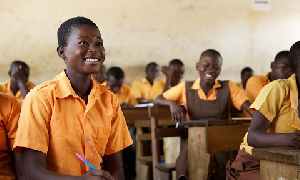Opinions of Monday, 16 March 2020
Columnist: Okota-Wilson Nicholas
Impact of the structure of break time on students' learning at the JHS level
At the junior high school in Ghana, students are to sit for thirty-five (35) minutes for a period (lesson) on the timetable. Sometimes it occurs as a double period of seventy (70) minutes. Where in most schools there are nine (9) or ten (10) periods a day. There will be three (3) continuous periods in the morning then a break of twenty-five (25) minutes or thirty (30) minutes depending on the school.
The lessons continue two (2) hours twenty (20) minutes ( 4 periods) with different subjects. The second break of also 25 or 30 minutes continues then the final set of 3 periods (in some cases 2 periods) of 1 hour 45 minutes continues. Lessons change immediately from one lesson to another with no break.
Meaning, as one teacher is literally getting out of the class, the other is already in the class. Sometimes, the incoming teacher will have to hang around the class to mount pressure on the teacher in the class to hurriedly end the lesson because time is up.
In such instance, most often, students tend to suffer as they do not make the right transition from one lesson to the other. Within the first five (5) minutes of the new lesson, that is when the student is mentally, physically and materially getting ready for the class.
This gets manifested in students thinking about previous knowledge with regards to the new class, what the teacher had demanded to be done before the start of (that) particular lesson.
Students will want to visit washroom, deal with some uncomfortable situation especially after sitting for two (2) periods of 1 hour ten minutes. If the student is not able to address these problems, it is going to distract attention throughout the lesson.
Materially, as the new lesson is at the Introduction stage where the teacher is connecting the student`s relevant previous knowledge (experience) to the new lesson, that is when the student will be putting books and materials for the the previous lesson away and getting the relevant books and materials for the ongoing lesson. There is high chance for the student losing most part of the foundation of the lesson which will go a long way to negatively affect the grasping and understanding of what continues in the lesson.
In some cases too, as the previous lesson is ongoing and the student sees the next teacher around, attention shift from the current lesson to the teacher outside and what will happen especially when there is (unique) attitude from the students towards the coming teacher and the subject.
Such a situation will make the student not to grasp the conclusion of the ongoing lesson well. All these problems are associated with the non-stop continues flow of periods/lessons where a lesson continues immediately after the other without a break.
In attempt to address this situation, a look should be taken at the Japanese system where at the junior high school, there is a fifty (50) minute period ( for a lesson) and at the end of each period, there is a ten (10) minute break for students before the next lesson begins.
So in between periods there is ten (10) minute break. It is after the fourth period that students will have their lunch break. This ten (10) minute recess is used by students to make the right transition to the next class; prepare themsleves mentally, physically and materially for the lesson.
Students take the advantage to visit the washroom if need be, attend to any physical need which had occured, get all the necessary materials needed for the lesson. They can even have the time to correct and clarify any difficulty in the previous lesson from classmates or the teacher. To the teachers, this ten (10) minute break helps them not to rush to conclude a lesson because the next teacher is around the corner.
The teacher will also have the full attention of the student throughout the lesson especially at the Introduction stage because they are fully prepared for the lesson which will end up being a very successful one.
This system can be adopted in Ghana; not necessarily the whole recess or break time structure as practised exactly in Japan but can be modified to suit the peculiar situation in the country. At least, there should be the incorporation of the short breaks in between lessons on the timetable; meaning the shift from keeping students in the class for a long period of time before break and the immediate change of class from one lesson to the other without giving students ample time to make the right transition from one lesson to the other.
Okota-Wilson Nicholas
[email protected]
Entertainment










